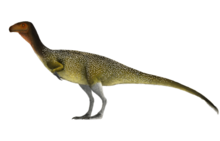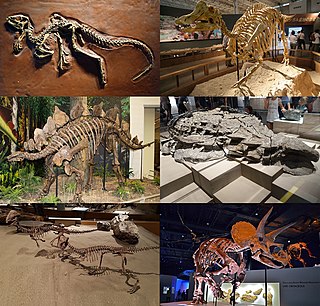
Ornithischia is an extinct clade of mainly herbivorous dinosaurs characterized by a pelvic structure superficially similar to that of birds. The name Ornithischia, or "bird-hipped", reflects this similarity and is derived from the Greek stem ornith- (ὀρνιθ-), meaning "bird", and ischion (ἴσχιον), meaning "hip". However, birds are only distantly related to this group as birds are theropod dinosaurs. Ornithischians with well known anatomical adaptations include the ceratopsians or "horn-faced" dinosaurs, the pachycephalosaurs or "thick-headed" dinosaurs, the armored dinosaurs (Thyreophora) such as stegosaurs and ankylosaurs, and the ornithopods. There is strong evidence that certain groups of ornithischians lived in herds, often segregated by age group, with juveniles forming their own flocks separate from adults. Some were at least partially covered in filamentous pelts, and there is much debate over whether these filaments found in specimens of Tianyulong, Psittacosaurus, and Kulindadromeus may have been primitive feathers.

Eoraptor is a genus of small, lightly built, basal sauropodomorph dinosaur. One of the earliest-known dinosaurs and one of the earliest members of the sauropod family, it lived approximately 231 to 228 million years ago, during the Late Triassic in Western Gondwana, in the region that is now northwestern Argentina. The type and only species, Eoraptor lunensis, was first described in 1993, and is known from an almost complete and well-preserved skeleton and several fragmentary ones. Eoraptor had multiple tooth shapes, which suggests that it was omnivorous. Eoraptor was 1.5 feet (0.46 m) tall and 3 feet (0.91 m) long.

Sauropodomorpha is an extinct clade of long-necked, herbivorous, saurischian dinosaurs that includes the sauropods and their ancestral relatives. Sauropods generally grew to very large sizes, had long necks and tails, were quadrupedal, and became the largest animals to ever walk the Earth. The prosauropods, which preceded the sauropods, were smaller and were often able to walk on two legs. The sauropodomorphs were the dominant terrestrial herbivores throughout much of the Mesozoic Era, from their origins in the Late Triassic until their decline and extinction at the end of the Cretaceous.

Herrerasauridae is a family of carnivorous dinosaurs, possibly basal to either theropods or even all of saurischians, or even their own branching from Dracohors, separate from Dinosauria altogether. They are among the oldest known dinosaurs, first appearing in the fossil record around 233.23 million years ago, before becoming extinct by the end of the Carnian stage. Herrerasaurids were relatively small-sized dinosaurs, normally no more than 4 metres (13 ft) long, although the holotype specimen of "Frenguellisaurus ischigualastensis" is thought to have reached around 6 meters long. The best known representatives of this group are from South America, where they were first discovered in the 1930s in relation to Staurikosaurus and 1960s in relation to Herrerasaurus. A nearly complete skeleton of Herrerasaurus ischigualastensis was discovered in the Ischigualasto Formation in San Juan, Argentina, in 1988. Less complete possible herrerasaurids have been found in North America and Africa, and they may have inhabited other continents as well.

Therizinosaurs are an extinct group of large herbivorous theropod dinosaurs whose fossils have been found across the Middle Jurassic to Late Cretaceous deposits in Europe, Asia and North America. Various features of the forelimbs, skull and pelvis unite these finds as both theropods and maniraptorans, making them relatives of birds. The name of the representative genus, Therizinosaurus, is derived from the Greek θερίζω and σαῦρος. The older representative, Segnosaurus, is derived from the Latin sēgnis ('slow') and the Greek σαῦρος.

Saurischia is one of the two basic divisions of dinosaurs, classified by their hip structure. Saurischia and Ornithischia were originally called orders by Harry Seeley in 1888 though today most paleontologists classify Saurischia as an unranked clade rather than an order.

Guaibasauridae is a family of basal sauropodomorph dinosaurs, known from fossil remains of late Triassic period formations in Brazil, Argentina and India.
Fernando Emilio Novas is an Argentine paleontologist working for the Comparative Anatomy Department of the Bernardino Rivadavia Natural Sciences Museum in Buenos Aires, Argentina. Novas holds a PhD in Natural sciences.

Phytodinosauria is a group of dinosaurs proposed in 1986, combining the Sauropodomorpha and Ornithischia as sister groups, conceptualized as a superorder of herbivorous dinosaurs excluding the carnivorous Theropoda. This hypothesis has been refuted by modern cladistic analysis, showing such a group to be polyphyletic. Modern studies either combine the Theropoda and Sauropodormorpha in the Saurischia or the Theropoda and Ornithischia in the Ornithoscelida.
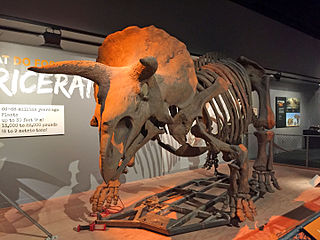
Ornithoscelida is a proposed clade that includes various major groupings of dinosaurs. An order Ornithoscelida was originally proposed by Thomas Henry Huxley but later abandoned in favor of Harry Govier Seeley's division of Dinosauria into Saurischia and Ornithischia. The term was revived in 2017 after a new cladistic analysis by Baron et al.
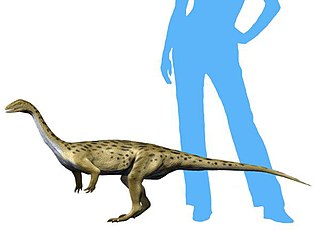
Saturnaliidae is a family of basal sauropodomorph dinosaurs found in Brazil, Argentina and possibly Zimbabwe. It is not to be confused with Saturnalidae, a family of radiolarian protists.

Zuolong is an extinct genus of tetanuran theropod from the Late Jurassic period of China. The type and only species is Z. salleei. The generic name of Zuolong is in honor of General Zu Zōngtáng with the Chinese word "long" which means dragon. The specific epithet "salleei" is in honor of Hilmar Sallee, who funded the expedition which led to the specimen's discovery.
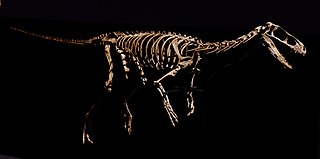
Eodromaeus is an extinct genus of probable basal theropod dinosaurs from the Late Triassic of Argentina. Like many other of the earliest-known dinosaurs, it hails from the Carnian-age Ischigualasto Formation, within the Ischigualasto-Villa Unión Basin of northwestern Argentina. Upon its discovery, it was argued to be one of the oldest true theropods, supplanting its contemporary Eoraptor, which was reinterpreted as a basal sauropodomorph.
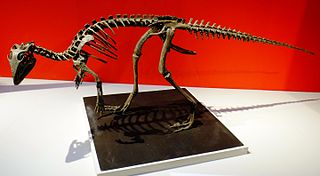
Kulindadromeus was a herbivorous dinosaur, a basal neornithischian from the Middle Jurassic. The first Kulindadromeus fossil was found in Russia. Its feather-like integument is evidence for protofeathers being basal to Ornithischia and possibly Dinosauria as a whole, rather than just to Coelurosauria, as previously suspected.

Laquintasaura is a genus of Venezuelan ornithischian dinosaur containing only the type species Laquintasaura venezuelae. The species was the first dinosaur to have been identified from Venezuela. It is known from extensive remains, all from a singular bonebed locality which has been sampled for specimen blocks over the course of several expeditions, largely led by Marcelo R Sánchez-Villagra. A small, very primitive animal, it is known for its distinct dental anatomy and for being one of the earliest and most primitive ornithischians in the fossil record. Taxonomic uncertainty has led to conflicting theories that it is either as the base of Ornithischia or at the base of the subgroup Thyreophora. In either model, its dating to around 200 million years ago, at the start of the Jurassic, existence in equatorial latitudes, and primitive nature make it a key view into early ornithischian evolution. It's thought that Laquintasaura would've lived in groups and had a possible omnivorous diet, living on a seasonal alluvial plain and being preyed about by the contemporary Tachiraptor.

Buriolestes is a genus of early sauropodomorph dinosaurs from the Late Triassic Santa Maria Formation of the Paraná Basin in southern Brazil. It contains a single species, B. schultzi, named in 2016. The type specimen was found alongside a specimen of the lagerpetid dinosauromorph Ixalerpeton.
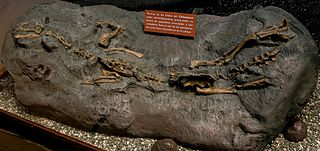
The Toqui Formation is a geological formation in the Aysén Region of southern Chile. It has been dated to the Tithonian stage of the Late Jurassic by uranium–lead dating of zircons, providing ages between 148.7 ± 1.4 Ma and 147 ± 1.0 Ma. It consists of an sequence of clastic sedimentary sandstones and conglomerates, interbedded with volcanic tuffs and ignimbrite. The dinosaurs Chilesaurus and indeterminate diplodocids and the mesoeucrocodylian Burkesuchus are known from the formation. The formation was deposited in a fluvio-deltaic environment.
The year 2017 in archosaur paleontology was eventful. Archosaurs include the only living dinosaur group — birds — and the reptile crocodilians, plus all extinct dinosaurs, extinct crocodilian relatives, and pterosaurs. Archosaur palaeontology is the scientific study of those animals, especially as they existed before the Holocene Epoch began about 11,700 years ago. The year 2017 in paleontology included various significant developments regarding archosaurs.
The year 2018 in non-avian dinosaur paleontology was eventful. Archosaurs include the only living dinosaur group — birds — and the reptile crocodilians, plus all extinct dinosaurs, extinct crocodilian relatives, and pterosaurs. Archosaur palaeontology is the scientific study of those animals, especially as they existed before the Holocene Epoch began about 11,700 years ago. This article records new taxa of fossil archosaurs of the non-avian variety that have been described during the year 2018, as well as other significant discoveries and events related to paleontology of archosaurs that occurred in the year 2018.

